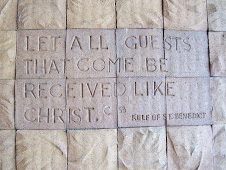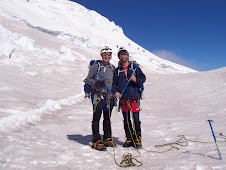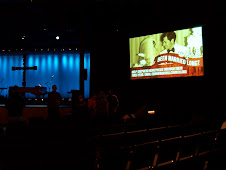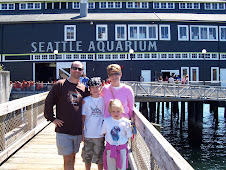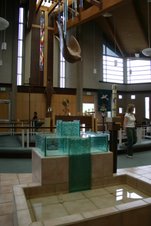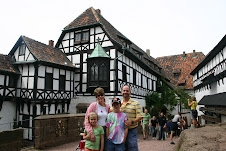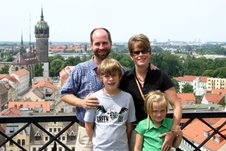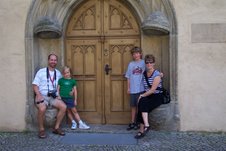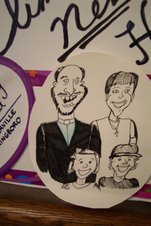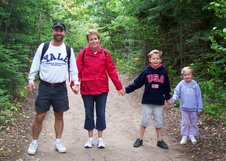For Gethsemani pix, hit this: http://picasaweb.google.com/fritzwiese/2007GethsemaniAbbeyTrappistKentucky
I am writing from my room at the monastery. From Friday, Aug 10 to Monday Aug 13, I am on spiritual retreat at Gethsemani Abbey in the rolling, rural setting of Trappist, Kentucky, just about 4 hours away from Dayton, and 20 minutes from Abraham Lincoln’s birthplace. Let me say, not talking for 4 days goes against the grain of this ENTJ Myers Briggs Type guy! But here “silence is spoken.” In case of emergency, we certainly can speak, and there are certain rooms and areas on the outdoor grounds where speech is permitted. But otherwise, 35 guests have joined the brothers of Gethsemani this long weekend in their daily rhythm of listening to God. Our complete silence in the dining room sure sounds different than the Wiese dinner table.
My vocal chords are primarily used for daily sung worship. The monks worship up to 7 times a day (3.15 AM, 5.45 AM, 7.30 AM, 12.15 PM, 2.15 PM, 5.30 PM and 7.30 PM), but three-four services per day has been my commitment. Compared to these guys, I’m a worship ‘slacker.’ Back in the 1960s, the sanctuary here at Gethsemani was redesigned by William Schickle, the artist who designed the lovely stained glassed window at Epiphany, entitled “The Spirit of the Lord Fills the Whole Earth,” in honor of Pastor Larry’s retirement. I understand there are lovely hiking and running trails on the grounds, but I find myself curiously drawn to focus on the simplistic routine for meditation, prayer, worship, reading and reflection—especially in light of my body still recovering from the Mount Rainier climb/odyssey. J
In 1098 the Cistercian Order of the Benedictine tradition arose. Its expansion was rapid and far reaching, including hundreds of houses across Europe. Through the Dark Ages, it was monasteries like these that helped “preserve” civilization in many regards. In 1848, the abbey of Melleray in France sent monks to establish Gethsemani, the first abbey in the United States. World famous Thomas Merton is one of the monks of Gethsemani who furthered this abbey’s reputation. Today, the monks follow a three-fold daily rhythm: prayer, work, and sacred reading. I’m writing from a comfortable, air conditioned simple room; the monks live in un-airconditioned, unadorned rooms, but experience God’s love and joy richly in community. They view their life as a complete, typical human life, simply having intentionally eliminated the “noise” of the world, which in their mind detracts and interferes with our Christian focus of praising God.
In addition to wonderful memories of reflection and prayer, I’ll be bringing back some fudge and cheese made by the brothers, the sale of which is their primary means of support. Gethsemani is a retreat center open to Christians of all backgrounds. Weekend and weekday retreats are available at no cost; a freewill offering is accepted. Please consider taking advantage of this wonderful retreat space in God’s kingdom, just a short drive away from Dayton. I’d be glad to talk to you more about it.
Monday, August 13, 2007
Reflections on Rainier
Climbing to New Heights on Mount Rainier
For Pix, click here: http://picasaweb.google.com/fritzwiese/2007MtRainierClimbOdyssey
“It was the best of times; it was the worst of times.” Climbing to the summit of the 14,410 foot Mt. Rainier, known as the most physically demanding mountain ascent in the lower 48 states, was an exhausting, thrilling, at-times-scary, unforgettable odyssey. For a sabbatical entitled, “Climbing New Heights,” this event was designed as the pinnacle, in terms of the sabbatical’s physical dimension. A few years back, Tom Eldridge offered a popular book for Christian men entitled Wild at Heart. Eldridge argued that men’s lives are fully engaged by entering three spheres: a battle to fight, a woman to love, and an adventure to live. Rainier, our nation’s 3rd highest mountain (behind McKinley in Alaska and Whitney in California) certainly fell into the “adventure to live” category.
After a heart-opening series of days learning with the ministry of Mars Hill Church in Seattle, I picked up my college buddy, Andy Kipker, from the airport on Saturday, Aug 4 and drove to Whittaker’s Bunkhouse in Ashford, WA, which would serve as base-camp for the summit attempt. The next day, we did “school” with our professional guides at RMI (Rainier Mountaineering International), learning how to use an ice ax, crampons, rope systems, and self-arrest techniques in case you found yourself sliding down a 45 degree 1,000+ foot slope of ice, careening toward a gaping crevasse. That night, after stocking a backpack that would have tripped airport weight regulations, we spent a second night “resting,” since a few nerves prevented any sweet dreams or true sleep. Monday morning, our team, minus one who found the school too taxing, drove the 50 minute ride to Paradise inside the park. There, around 9 AM, day one of the climb began at the 5,500 foot base of the mountain; the paved path soon transitioned to snow field, and at 3.45, we had reached camp #2, Camp Muir at 10,000 feet. Muir provided an awesome vista. While clouds had rolled in at 5,000 feet, blanketing the northeast with cotton balls, our vantage was clear. Rising defiantly of the cotton clouds, Mt St. Helens, Mt. Hood and Mt. Adams all gleamed in the sun’s rays. Although compared to space, Rainier is nothing but a mole hill, we felt we were standing on top of the world—but we weren’t at the top yet.
The strategy was to eat our freeze dried dinners and then “rest” as best we could in the simple wooden shack that reminded me of the concentration camp bunkhouses I visited in Germany at the beginning of the summer. Earplugs helped a little bit with the rustling of others’ sleeping bags, but didn’t do much for the questions swirling inside each of our heads. “What would the weather be like? Were we up to the challenge? Did we pack everything we need? What if something happened?” After about 70 minutes of genuine sleep (for which I was grateful), I snuck outside to use the bathroom, and was rewarded with one of the journey’s profound pleasures: stars brilliant beyond belief. A miraculous Milky Way. That view and a renewed realization that “this is my Father’s world,” reminded me what a gift this opportunity was.
At 11 PM, our guide awoke us. It was time to eat and start. Of all those who attempt summiting Rainier, only 60% make it. Beyond physical and mental issues, one challenge is weather. This morning, we had been blessed with mild and clear air. So after hydrating and my billionth bagel, we roped up, secured crampons, illuminated our head-lamps, strapped on a pack that felt like both my children were hiding inside, and ventured off, minus a second of our mates, who had decided the climb “didn’t feel right.” It’s an eerie feeling climbing in the dark. Earlier in the summer, I had experienced the sensation at 4 AM on the start to Long’s Peak. Alone. No ambient light from starts or moon under the thick forest canopy. I had jumped pretty high when a small animal shattered the silence just off the path. At least here on Rainier, other lights shone than only my own. The disturbing difference soon emerged. Ten minutes into the climb, I noticed teammates ahead slowing off the pace for just a moment. When I arrived at the spot, the reason was clear: a two foot wide gaping crevasse. Jagged twisting walls were visible in the narrow beams of one’s head lamp, but not the bottom of the crevasse. That was left for your imagination. In a sense, I realized that was the most profound crossroad of the trip. Either you were going to trust in the security of your roped teammates and take the leap of faith, or you weren’t. That first two foot step (which felt like 10) wasn’t the widest of the trip, and it wasn’t the most narrow, but it felt great to feel the solid ice under my foot on the other side!
All in all, we were to traverse over 100 crevasses. 100 other “leaps of faith,” sometimes while hiking backwards, or up incredible angles. However, I don’t think you could count the number of steps as we pushed on to the 14,410 foot summit. We appreciated our guides steering us clear of Disappointment Clever, unpassable because of the late-summer crevasse chaos, but it meant that after ascending to that juncture, we had to DESCEND an extra 700 feet, hike a while, and then re-ascend the altitude. I think from Camp Muir, the trip to the summit is only 5 miles. But the mile UP, with each step in snow and ice, along with the extra ups and downs, plus the unrelenting pace of the guides who wanted to get us up and down before the weather turned, made it the physical challenge of my life. The last 60 minutes of my second Columbus Marathon were probably the most grueling single hour of my life; but in terms of a holistic experience, this summit climb, with the never-ending descent as kicking-butt compliment was the hardest.
Anyway, in terms of making a long account even longer, we celebrated the summit at 7.35 AM on Tuesday morning, August 7. We were so exhausted that not one of us took the guides up on the opportunity to walk across to the other side of the summit (which is a snowy volcano cauldron depression). I need to trace down the facts, but I think there is 66% less oxygen on the mountain than the oxygen rich atmosphere of Dayton, so we breathed. After 15 minutes of rest, a few photos, and forcing yourself to eat, the teams prepared for descent. By 1 PM, we had returned to Camp Muir. We quickly refilled water bottles, packed our sleeping backs, tended to blisters, and continued with the journey down to Paradise, where we arrived after a rainy, cloud covered progression at 5.30 PM.
Was it worth “climbing new heights” to the top of Mt Rainier? Absolutely! Would I do it again? No way, (unless a new house was involved, or a church capital campaign could be bypassed). This 40 year old had an itch, and Mt Rainier (along with Long’s Peak and some Switzerland Alps hikes) scratched it good. J Seeing God re-color the world with sunrise from the near summit of one of the country’s tallest peaks was uniquely spectacular and motivating. Committing all your God-given physical and mental energy toward a team effort that at moments seemed insecure, and then succeeding, was exhilarating and confidence-strengthening. Pushing the envelope on the side of such a inhospitable incline reminds you to treasure your abundant God-given comforts.
Moses certainly had his mountain moments. I’m no Moses. Maybe God thinks of climbs like this along the lines of the Babylonians trying to climb to the heavens with their ill-fated tower. But I’d like to hope that in the spirit of Moses, Noah, Jesus, and the Pentecost disciples, God gave me this mountain moment to clarify my relationship with Him and teach me a few things. Here are a few nuggets of faith insights from Mt Rainier that I’ll be praying about. Perhaps they’ll expand into a sermon one day:
· Christians need to rope up together. If somebody slips, we’ve got to make sure we catch each other. We’re all able to live more boldly, if we know others have our backs (or belts).
· You’re silly if you think you can make it up the mountain without a guide. Life-sucking crevasses loom hidden under the snow. You better be following someone who knows the lay of the land. Christians call this guide Jesus.
· On the mountain, there’s 66% less oxygen than at sea level. Mountain guides teach you how to breathe correctly; if you don’t work on breathing techniques, you’re in trouble. For Christians, we count on the resurrected Jesus breathing on us, as he did the first disciples. That changes everything. We need to pay attention to the Holy Spirit, our guide instructing us how to breathe the fresh air of new life.
· On the climb, you must eat and drink. Because of the altitude and exhaustion, sometimes you don’t feel like it. But it’s essential. As Christians, we rely on Jesus’ weekly feeding of us in worship, centered in the bread and wine of Eucharist. Sometimes, in our laziness, or because life has left us too tired, we don’t feel like getting to the Lord’s table on the weekends, but it makes all the difference.
· New vistas, insights, and confidence aren’t achieved without risks and sacrifice. The climb of faith includes at times heavy burdens (backpacks), scary leaps of faith (crevasses), periods of darkness when only the next few steps are visible, resting points that are so steep you’re water bottle will slide out of reach if you’re not careful, and slippery steep slopes that make every muscle in your leg burn. But we claim Jesus’ promise that he is our faithful guide “with us always, even to the end of the age” (or the end of the hike). With Jesus, out of the darkness, there comes a great light, and joy comes in the morning. Through the journey, we grow in fear and love of the One who made the mountain, who guides our steps on the mountain, and teaches us on the mountain. By following him as part of a team, we gain insight, confidence and ability to climb again and lead others on the journey.
· I pray that as Jesus’ disciples gained new insight by witnessing his Transfiguration on the mountain, so too, the Holy Spirit will sear into my spirit the lessons of this incredibly difficult, but exhilarating and insightful mountaintop experience of “climbing new heights.”
For Pix, click here: http://picasaweb.google.com/fritzwiese/2007MtRainierClimbOdyssey
“It was the best of times; it was the worst of times.” Climbing to the summit of the 14,410 foot Mt. Rainier, known as the most physically demanding mountain ascent in the lower 48 states, was an exhausting, thrilling, at-times-scary, unforgettable odyssey. For a sabbatical entitled, “Climbing New Heights,” this event was designed as the pinnacle, in terms of the sabbatical’s physical dimension. A few years back, Tom Eldridge offered a popular book for Christian men entitled Wild at Heart. Eldridge argued that men’s lives are fully engaged by entering three spheres: a battle to fight, a woman to love, and an adventure to live. Rainier, our nation’s 3rd highest mountain (behind McKinley in Alaska and Whitney in California) certainly fell into the “adventure to live” category.
After a heart-opening series of days learning with the ministry of Mars Hill Church in Seattle, I picked up my college buddy, Andy Kipker, from the airport on Saturday, Aug 4 and drove to Whittaker’s Bunkhouse in Ashford, WA, which would serve as base-camp for the summit attempt. The next day, we did “school” with our professional guides at RMI (Rainier Mountaineering International), learning how to use an ice ax, crampons, rope systems, and self-arrest techniques in case you found yourself sliding down a 45 degree 1,000+ foot slope of ice, careening toward a gaping crevasse. That night, after stocking a backpack that would have tripped airport weight regulations, we spent a second night “resting,” since a few nerves prevented any sweet dreams or true sleep. Monday morning, our team, minus one who found the school too taxing, drove the 50 minute ride to Paradise inside the park. There, around 9 AM, day one of the climb began at the 5,500 foot base of the mountain; the paved path soon transitioned to snow field, and at 3.45, we had reached camp #2, Camp Muir at 10,000 feet. Muir provided an awesome vista. While clouds had rolled in at 5,000 feet, blanketing the northeast with cotton balls, our vantage was clear. Rising defiantly of the cotton clouds, Mt St. Helens, Mt. Hood and Mt. Adams all gleamed in the sun’s rays. Although compared to space, Rainier is nothing but a mole hill, we felt we were standing on top of the world—but we weren’t at the top yet.
The strategy was to eat our freeze dried dinners and then “rest” as best we could in the simple wooden shack that reminded me of the concentration camp bunkhouses I visited in Germany at the beginning of the summer. Earplugs helped a little bit with the rustling of others’ sleeping bags, but didn’t do much for the questions swirling inside each of our heads. “What would the weather be like? Were we up to the challenge? Did we pack everything we need? What if something happened?” After about 70 minutes of genuine sleep (for which I was grateful), I snuck outside to use the bathroom, and was rewarded with one of the journey’s profound pleasures: stars brilliant beyond belief. A miraculous Milky Way. That view and a renewed realization that “this is my Father’s world,” reminded me what a gift this opportunity was.
At 11 PM, our guide awoke us. It was time to eat and start. Of all those who attempt summiting Rainier, only 60% make it. Beyond physical and mental issues, one challenge is weather. This morning, we had been blessed with mild and clear air. So after hydrating and my billionth bagel, we roped up, secured crampons, illuminated our head-lamps, strapped on a pack that felt like both my children were hiding inside, and ventured off, minus a second of our mates, who had decided the climb “didn’t feel right.” It’s an eerie feeling climbing in the dark. Earlier in the summer, I had experienced the sensation at 4 AM on the start to Long’s Peak. Alone. No ambient light from starts or moon under the thick forest canopy. I had jumped pretty high when a small animal shattered the silence just off the path. At least here on Rainier, other lights shone than only my own. The disturbing difference soon emerged. Ten minutes into the climb, I noticed teammates ahead slowing off the pace for just a moment. When I arrived at the spot, the reason was clear: a two foot wide gaping crevasse. Jagged twisting walls were visible in the narrow beams of one’s head lamp, but not the bottom of the crevasse. That was left for your imagination. In a sense, I realized that was the most profound crossroad of the trip. Either you were going to trust in the security of your roped teammates and take the leap of faith, or you weren’t. That first two foot step (which felt like 10) wasn’t the widest of the trip, and it wasn’t the most narrow, but it felt great to feel the solid ice under my foot on the other side!
All in all, we were to traverse over 100 crevasses. 100 other “leaps of faith,” sometimes while hiking backwards, or up incredible angles. However, I don’t think you could count the number of steps as we pushed on to the 14,410 foot summit. We appreciated our guides steering us clear of Disappointment Clever, unpassable because of the late-summer crevasse chaos, but it meant that after ascending to that juncture, we had to DESCEND an extra 700 feet, hike a while, and then re-ascend the altitude. I think from Camp Muir, the trip to the summit is only 5 miles. But the mile UP, with each step in snow and ice, along with the extra ups and downs, plus the unrelenting pace of the guides who wanted to get us up and down before the weather turned, made it the physical challenge of my life. The last 60 minutes of my second Columbus Marathon were probably the most grueling single hour of my life; but in terms of a holistic experience, this summit climb, with the never-ending descent as kicking-butt compliment was the hardest.
Anyway, in terms of making a long account even longer, we celebrated the summit at 7.35 AM on Tuesday morning, August 7. We were so exhausted that not one of us took the guides up on the opportunity to walk across to the other side of the summit (which is a snowy volcano cauldron depression). I need to trace down the facts, but I think there is 66% less oxygen on the mountain than the oxygen rich atmosphere of Dayton, so we breathed. After 15 minutes of rest, a few photos, and forcing yourself to eat, the teams prepared for descent. By 1 PM, we had returned to Camp Muir. We quickly refilled water bottles, packed our sleeping backs, tended to blisters, and continued with the journey down to Paradise, where we arrived after a rainy, cloud covered progression at 5.30 PM.
Was it worth “climbing new heights” to the top of Mt Rainier? Absolutely! Would I do it again? No way, (unless a new house was involved, or a church capital campaign could be bypassed). This 40 year old had an itch, and Mt Rainier (along with Long’s Peak and some Switzerland Alps hikes) scratched it good. J Seeing God re-color the world with sunrise from the near summit of one of the country’s tallest peaks was uniquely spectacular and motivating. Committing all your God-given physical and mental energy toward a team effort that at moments seemed insecure, and then succeeding, was exhilarating and confidence-strengthening. Pushing the envelope on the side of such a inhospitable incline reminds you to treasure your abundant God-given comforts.
Moses certainly had his mountain moments. I’m no Moses. Maybe God thinks of climbs like this along the lines of the Babylonians trying to climb to the heavens with their ill-fated tower. But I’d like to hope that in the spirit of Moses, Noah, Jesus, and the Pentecost disciples, God gave me this mountain moment to clarify my relationship with Him and teach me a few things. Here are a few nuggets of faith insights from Mt Rainier that I’ll be praying about. Perhaps they’ll expand into a sermon one day:
· Christians need to rope up together. If somebody slips, we’ve got to make sure we catch each other. We’re all able to live more boldly, if we know others have our backs (or belts).
· You’re silly if you think you can make it up the mountain without a guide. Life-sucking crevasses loom hidden under the snow. You better be following someone who knows the lay of the land. Christians call this guide Jesus.
· On the mountain, there’s 66% less oxygen than at sea level. Mountain guides teach you how to breathe correctly; if you don’t work on breathing techniques, you’re in trouble. For Christians, we count on the resurrected Jesus breathing on us, as he did the first disciples. That changes everything. We need to pay attention to the Holy Spirit, our guide instructing us how to breathe the fresh air of new life.
· On the climb, you must eat and drink. Because of the altitude and exhaustion, sometimes you don’t feel like it. But it’s essential. As Christians, we rely on Jesus’ weekly feeding of us in worship, centered in the bread and wine of Eucharist. Sometimes, in our laziness, or because life has left us too tired, we don’t feel like getting to the Lord’s table on the weekends, but it makes all the difference.
· New vistas, insights, and confidence aren’t achieved without risks and sacrifice. The climb of faith includes at times heavy burdens (backpacks), scary leaps of faith (crevasses), periods of darkness when only the next few steps are visible, resting points that are so steep you’re water bottle will slide out of reach if you’re not careful, and slippery steep slopes that make every muscle in your leg burn. But we claim Jesus’ promise that he is our faithful guide “with us always, even to the end of the age” (or the end of the hike). With Jesus, out of the darkness, there comes a great light, and joy comes in the morning. Through the journey, we grow in fear and love of the One who made the mountain, who guides our steps on the mountain, and teaches us on the mountain. By following him as part of a team, we gain insight, confidence and ability to climb again and lead others on the journey.
· I pray that as Jesus’ disciples gained new insight by witnessing his Transfiguration on the mountain, so too, the Holy Spirit will sear into my spirit the lessons of this incredibly difficult, but exhilarating and insightful mountaintop experience of “climbing new heights.”
Sunday, August 5, 2007
Ministry at Mars Hill
Reflections on Mars Hill Church, Seattle, Washington
For pix, click here: http://picasaweb.google.com/fritzwiese/2007MarsHillChurchSeattle
What’s Captivating about the Ministry at Mars Hill Church . . .
They’ve grown from a weekly bible study the pastor lead in his home in the mid 1990s to a worshipping community of about 6,000/weekly today.
Their lead pastor, Mark Driscoll, has written two books that I read and enjoyed thoroughly. They are inspiring, honest, and insightful about both theology/missiology and the nuts and bolts of doing church in an uninterested 21st century urban America. He’s a funny, witty, and irreverent writer. Confessions of Reformissionary Rev and The Radical Reformission. I love the combination of humor, realism, and love for Jesus and his church. I don’t agree with his whole approach, but he’s a blessing to the church.
Seattle has been called the most “unchurched” city in America. In the last census, it was the first time “None” was the most frequent reply when asked to list “religious preference,” (as opposed to Christian, Jewish, Muslim, etc). Yet Mars Hill effectively connects with citizens who are highly irreligious.
A strong expectation of members. Mars Hill worship services usually are comprised of only 40% of members. The rest are visitors. If you want to be a member, you’re required to take an 8 session Gospel Class. At the end, you must sign a covenant that you’ll be in a small group, that you’ll give well to the church, and that you’ll worship and attend bible studies regularly. Many people don’t sign the covenant and leave the church; but Mars Hill is comfortable with that. They don’t want to foster a consumerism Christianity. They make clear that the expectations Jesus has for disciples are high—and in that expectation and commitment to discipline, joy is found.
Services that include weekly communion and child participation. Just as with my visit to Abiding Hope Lutheran, I found services that make sure children are included. While for the first 55 minutes of the service children go to “kids church,” when it’s time for communion, parents retrieve their kids so they may commune as a family and sing the final songs together. Again, they must know that the #1 faith formation factor for children is to worship with and alonside their parents—not just make it to a Sunday School experience.
A freedom to be culturally liberal and biblically conservative. What does this mean? Mars Hill realizes they can’t do it all. So they fully and exclusively embrace the music of today, with contemporary worship being lead by leading musicians in the Seattle club culture (most volunteers). (Classical Christian hymns are sung, but lead by a rock band.) Embracing beer, tattoos, a variety of hair styles, cinema, the internet and blogs, and outdoor recreation as marks and tools of today’s culture, and using them for ministry. Like Jesus, a proactive desire to hang out with “sinners,” to walk through Samaria, and deal with the very real questions and quandaries that today’s people have about faith (instead of maintaining an exclusively “proper and respectable” church culture. But while they are socially liberal, Mars Hill is biblically conservative and takes very seriously the biblical gospel of justified by grace through faith, calls to repentance and growth in discipleship, for good works for neighbor out in the world.
A realization that ministry is done both with attraction (top notch worship, a plethora of community small groups, bible studies that answer real questions—things people can come to) AND mission (getting every disciple fired up about reaching out to their friends and neighbors about the kingdom of God—going ‘out’ and ‘to.’) Mars Hill says that most attendees are missionaries before they are believers. They are inviting their friends to check out what’s going on at church or in small groups BEFORE they fully understand their theological stance or have made a formal commitment to Jesus. For them, evangelism is a lifestyle and not just an outreach program.
A commitment that mission growth needed a multi-site campus strategy. Mars Hill now supports 3 campuses, with plans for 3 more in the next 18 months.
A leadership development process where visitors can grow into members, and members can then take the next step of becoming a deacon, with special leadership responsibilities in the church. There is an attitude of service-leadership fostered. For those deacons who want to then become elders, they are required to serve a 12 month unpaid full time internship, before consideration by the other elders.
A realization that discipleship today requires a three-fold balance.
a. Those who love the gospel and culture, but don’t commit to church life is the parachurch. Maybe groups like Young Life are great for the moment, but unless they take the larger church seriously, they connect the culture to Jesus without connecting them to the rest of Jesus’ people. After college, they have no connection and float in isolation. This can lead to theological immaturity, with saved people encouraged to do little more than get other people saved. (Driscoll, The Radical Reformission, 21)
b. Church + Culture - Gospel = Liberalism. Some churches (and we mainliners are probably very guilty) convert folks to loving people and doing good works, but perhaps we don’t help people repent and develop a personal, growing relationship experience with Jesus. A full discipleship transformation isn’t taken seriously. But with Martin Luther’s strong track record, I think we’ve got a great corrective model.
c. Church + Gospel – Culture = Fundamentalism. Many Christians love the Bible, but hold culture in disdain. They’re waiting for the culture to come to them. They get inwardly focused in tradition, and replace the gospel love toward others with rigid morality, superiority and simple proof-texting of Scripture.
d. Mars Hill outlines a path striving to hold gospel, culture, and church in faithful tension with each other. From their recent history, it sounds like they’re doing a great job.
* Worship, interviews, and reading of Mars Hills books all served as great inspiration for analyzing Epiphany’s current crossroads on multi-site ministry and a desire for a more robust program for discipleship development. I’m continuing to read, reflect, pray, and organize the taped interviews I conducted for our fall retreats with leadership teams.
For pix, click here: http://picasaweb.google.com/fritzwiese/2007MarsHillChurchSeattle
What’s Captivating about the Ministry at Mars Hill Church . . .
They’ve grown from a weekly bible study the pastor lead in his home in the mid 1990s to a worshipping community of about 6,000/weekly today.
Their lead pastor, Mark Driscoll, has written two books that I read and enjoyed thoroughly. They are inspiring, honest, and insightful about both theology/missiology and the nuts and bolts of doing church in an uninterested 21st century urban America. He’s a funny, witty, and irreverent writer. Confessions of Reformissionary Rev and The Radical Reformission. I love the combination of humor, realism, and love for Jesus and his church. I don’t agree with his whole approach, but he’s a blessing to the church.
Seattle has been called the most “unchurched” city in America. In the last census, it was the first time “None” was the most frequent reply when asked to list “religious preference,” (as opposed to Christian, Jewish, Muslim, etc). Yet Mars Hill effectively connects with citizens who are highly irreligious.
A strong expectation of members. Mars Hill worship services usually are comprised of only 40% of members. The rest are visitors. If you want to be a member, you’re required to take an 8 session Gospel Class. At the end, you must sign a covenant that you’ll be in a small group, that you’ll give well to the church, and that you’ll worship and attend bible studies regularly. Many people don’t sign the covenant and leave the church; but Mars Hill is comfortable with that. They don’t want to foster a consumerism Christianity. They make clear that the expectations Jesus has for disciples are high—and in that expectation and commitment to discipline, joy is found.
Services that include weekly communion and child participation. Just as with my visit to Abiding Hope Lutheran, I found services that make sure children are included. While for the first 55 minutes of the service children go to “kids church,” when it’s time for communion, parents retrieve their kids so they may commune as a family and sing the final songs together. Again, they must know that the #1 faith formation factor for children is to worship with and alonside their parents—not just make it to a Sunday School experience.
A freedom to be culturally liberal and biblically conservative. What does this mean? Mars Hill realizes they can’t do it all. So they fully and exclusively embrace the music of today, with contemporary worship being lead by leading musicians in the Seattle club culture (most volunteers). (Classical Christian hymns are sung, but lead by a rock band.) Embracing beer, tattoos, a variety of hair styles, cinema, the internet and blogs, and outdoor recreation as marks and tools of today’s culture, and using them for ministry. Like Jesus, a proactive desire to hang out with “sinners,” to walk through Samaria, and deal with the very real questions and quandaries that today’s people have about faith (instead of maintaining an exclusively “proper and respectable” church culture. But while they are socially liberal, Mars Hill is biblically conservative and takes very seriously the biblical gospel of justified by grace through faith, calls to repentance and growth in discipleship, for good works for neighbor out in the world.
A realization that ministry is done both with attraction (top notch worship, a plethora of community small groups, bible studies that answer real questions—things people can come to) AND mission (getting every disciple fired up about reaching out to their friends and neighbors about the kingdom of God—going ‘out’ and ‘to.’) Mars Hill says that most attendees are missionaries before they are believers. They are inviting their friends to check out what’s going on at church or in small groups BEFORE they fully understand their theological stance or have made a formal commitment to Jesus. For them, evangelism is a lifestyle and not just an outreach program.
A commitment that mission growth needed a multi-site campus strategy. Mars Hill now supports 3 campuses, with plans for 3 more in the next 18 months.
A leadership development process where visitors can grow into members, and members can then take the next step of becoming a deacon, with special leadership responsibilities in the church. There is an attitude of service-leadership fostered. For those deacons who want to then become elders, they are required to serve a 12 month unpaid full time internship, before consideration by the other elders.
A realization that discipleship today requires a three-fold balance.
a. Those who love the gospel and culture, but don’t commit to church life is the parachurch. Maybe groups like Young Life are great for the moment, but unless they take the larger church seriously, they connect the culture to Jesus without connecting them to the rest of Jesus’ people. After college, they have no connection and float in isolation. This can lead to theological immaturity, with saved people encouraged to do little more than get other people saved. (Driscoll, The Radical Reformission, 21)
b. Church + Culture - Gospel = Liberalism. Some churches (and we mainliners are probably very guilty) convert folks to loving people and doing good works, but perhaps we don’t help people repent and develop a personal, growing relationship experience with Jesus. A full discipleship transformation isn’t taken seriously. But with Martin Luther’s strong track record, I think we’ve got a great corrective model.
c. Church + Gospel – Culture = Fundamentalism. Many Christians love the Bible, but hold culture in disdain. They’re waiting for the culture to come to them. They get inwardly focused in tradition, and replace the gospel love toward others with rigid morality, superiority and simple proof-texting of Scripture.
d. Mars Hill outlines a path striving to hold gospel, culture, and church in faithful tension with each other. From their recent history, it sounds like they’re doing a great job.
* Worship, interviews, and reading of Mars Hills books all served as great inspiration for analyzing Epiphany’s current crossroads on multi-site ministry and a desire for a more robust program for discipleship development. I’m continuing to read, reflect, pray, and organize the taped interviews I conducted for our fall retreats with leadership teams.
Thursday, August 2, 2007
Spirited in Seattle
For Seattle pix, click here: http://picasaweb.google.com/fritzwiese/2007SeattleFun
After a wonderful family retreat in Holden Village, our family spent a few days together in Seattle before LuAnne, Luke and Morgan flew home. We enjoyed the world famous Pike’s Place Fish Market, where the staff throw fish around, along with clam chowder at Ivar’s and a tour of the Seattle Aquarium, with its octopus and sea otters. (We learned a sea otter can stay warm because it has over one million hairs per square inch on its body; Fritz is disappointed he can’t match those follicle statistics. Before visiting with Mars Hill Church, Fritz took his camera to Mt Rainier National Park to take a few shots of the mountain in front of Reflection Lake. Witnessing a bald eagle take a fish out of the lake, just after snapping a shot, was a highlight of the visit. From the hundreds of suction cups on an octopus’ tentacles to wildflowers in front of the mountains—again, God’s beauty, ingenuity and glory, shine forth.
After a wonderful family retreat in Holden Village, our family spent a few days together in Seattle before LuAnne, Luke and Morgan flew home. We enjoyed the world famous Pike’s Place Fish Market, where the staff throw fish around, along with clam chowder at Ivar’s and a tour of the Seattle Aquarium, with its octopus and sea otters. (We learned a sea otter can stay warm because it has over one million hairs per square inch on its body; Fritz is disappointed he can’t match those follicle statistics. Before visiting with Mars Hill Church, Fritz took his camera to Mt Rainier National Park to take a few shots of the mountain in front of Reflection Lake. Witnessing a bald eagle take a fish out of the lake, just after snapping a shot, was a highlight of the visit. From the hundreds of suction cups on an octopus’ tentacles to wildflowers in front of the mountains—again, God’s beauty, ingenuity and glory, shine forth.
Sunday, July 29, 2007
Hilghlights from Holden Village
* Click here to see pix from Holden Village http://picasaweb.google.com/fritzwiese/2007HoldenVillage
* Taking a 2 hour boat ride north on Lake Chelan, followed by a half hour bus ride up the mountain to get to the Village. It's so remote, that's the only way!
* Realizing this camp is a wonderful illustration of God's grace. A copper and gold mine was established in the early part of the 1900s, in a very remote part of the North Cascade Mountain Range. A small village was built to house the miners and their families, complete with a little bowling alley, pool hall, and ice cream shop. In 1960, when it was no longer profitable to transport thee copper for sale, the mining company gave the camp--and all its contents--to the Lutheran Church for $1. A wonderful, unexpected gift--just like God's daily grace to us. Then the Lutherans had to figure out how they would respond (just as each of us does, in light of all God entrusts to us). Since 1960, Holden Village has been a retreat experience for Christians (all are welcome) to gather for a combination of worship, learning, ice cream, and some wilderness hiking that is difficult to match.
* Coming here with my family. My first (and only time) at Holden was when I came with my family in 4th grade. To bring a 6th and 2nd grader of my own, and experience camp through their eyes was a hoot. The most vivid memory I have of my own experience at Holden from 1976 was my passion for setting up pins manually in back of the bowling alleys. Guess what? You could be sure to find Luke and Morgan in the bowling alley every chance they got, setting up pins.
* Worshipping in the pew right behind Herb Brokering, author of the hymn classic, "Earth and All Stars." Herb was one of the terrific speakers/teachers for the week, and LuAnne and I enjoyed several talks with him and his family. John Marty (son of Martin Marty) talked about his position as Minnesota state senator and his work on health care reform, along with the academic dean from Luther Seminary, David Lose, teaching on the interpretation of Scripture. Wonderful, stimulating bible studies and lectures.
* Taking a hike with Luke to Heart Lake, where the flies were so bad, we didn't even sit down for lunch. Hopefully "time will heal all wounds" with Luke's memories of this hike of gorgeous scenery--much of which we couldn't see much, bc we were so busy swatting biting flies. :)
*Watching "The Sound of Music" on the first night, on a huge makeshift movie screen, out in the open, surrounded by real 9,000 foot mountains of the Cascades, and canopied by brilliant stars, as we watched Julie Andrews running through the mountains on screen.
* Experiencing, once again, old friends in the communion of saints. One of the campers that week was Jana Schofield, who many Epiphanyites remembers as ELC's youth director from appx. 1994-1996. Jana was departing for seminary just as I was arriving. It was a delight to catch up with Jana, meet her husband and extended family. Jana's doing great ministry in California, part time with a church, and part time with campus ministry.
* Countless other wonderful moments of God's grace and renewal in this gorgeous, stimulating mountain retreat village God gave to our church.
* Now it's on to Seattle, to learn from Mars Hill Church.
* Taking a 2 hour boat ride north on Lake Chelan, followed by a half hour bus ride up the mountain to get to the Village. It's so remote, that's the only way!
* Realizing this camp is a wonderful illustration of God's grace. A copper and gold mine was established in the early part of the 1900s, in a very remote part of the North Cascade Mountain Range. A small village was built to house the miners and their families, complete with a little bowling alley, pool hall, and ice cream shop. In 1960, when it was no longer profitable to transport thee copper for sale, the mining company gave the camp--and all its contents--to the Lutheran Church for $1. A wonderful, unexpected gift--just like God's daily grace to us. Then the Lutherans had to figure out how they would respond (just as each of us does, in light of all God entrusts to us). Since 1960, Holden Village has been a retreat experience for Christians (all are welcome) to gather for a combination of worship, learning, ice cream, and some wilderness hiking that is difficult to match.
* Coming here with my family. My first (and only time) at Holden was when I came with my family in 4th grade. To bring a 6th and 2nd grader of my own, and experience camp through their eyes was a hoot. The most vivid memory I have of my own experience at Holden from 1976 was my passion for setting up pins manually in back of the bowling alleys. Guess what? You could be sure to find Luke and Morgan in the bowling alley every chance they got, setting up pins.
* Worshipping in the pew right behind Herb Brokering, author of the hymn classic, "Earth and All Stars." Herb was one of the terrific speakers/teachers for the week, and LuAnne and I enjoyed several talks with him and his family. John Marty (son of Martin Marty) talked about his position as Minnesota state senator and his work on health care reform, along with the academic dean from Luther Seminary, David Lose, teaching on the interpretation of Scripture. Wonderful, stimulating bible studies and lectures.
* Taking a hike with Luke to Heart Lake, where the flies were so bad, we didn't even sit down for lunch. Hopefully "time will heal all wounds" with Luke's memories of this hike of gorgeous scenery--much of which we couldn't see much, bc we were so busy swatting biting flies. :)
*Watching "The Sound of Music" on the first night, on a huge makeshift movie screen, out in the open, surrounded by real 9,000 foot mountains of the Cascades, and canopied by brilliant stars, as we watched Julie Andrews running through the mountains on screen.
* Experiencing, once again, old friends in the communion of saints. One of the campers that week was Jana Schofield, who many Epiphanyites remembers as ELC's youth director from appx. 1994-1996. Jana was departing for seminary just as I was arriving. It was a delight to catch up with Jana, meet her husband and extended family. Jana's doing great ministry in California, part time with a church, and part time with campus ministry.
* Countless other wonderful moments of God's grace and renewal in this gorgeous, stimulating mountain retreat village God gave to our church.
* Now it's on to Seattle, to learn from Mars Hill Church.
Sunday, July 22, 2007
Prayer and Play in the Parks
Our recent week on the road featured God’s beauty as revealed in our national parks. First, we spent several nights in a little cabin on the edge of Rocky Mountain National Park. It was a great launching pad for some beautiful hikes and animal watching. What a thrill to see big horn sheep, elk, marmots and deer. Fritz was able to climb Long’s Peak—and actually saw Epiphany member John Riedl at the top! On another hike, we met friends of Jan and Don Panning. The communion of saints truly is a world-wide body. The Rockies was a fertile location for prayer, reading, and enjoying a special edge of God’s creativity. Plus, the kids found a few fun things to do in town like huge trampolines and slides. Morgan even worked hard, completing the activities to become a Junior Park Ranger! http://picasaweb.google.com/fritzwiese/RockyMountains
On our way westward, we were able to spend just one full day exploring the Grand Tetons and Yellowstone. But we were treated to quick encounters with bison, elk, a momma moose, a coyote, the eruption of Old Faithful, and the sulphuric painted pots.http://picasaweb.google.com/fritzwiese/TetonsAndYellowstone
This is the first time we’ve had internet access for quite awhile, so sorry for the brief update. Now, it’s a long day of driving from Bozeman, Montana to Chelan, Washington. Tomorrow, we take the boat to the Lutheran Camp of Holden Village, a place remote from internet, phones, etc, high in the Cascade mountain range. We look forward to what God has in store for us in that faith community. More to come . . .
On our way westward, we were able to spend just one full day exploring the Grand Tetons and Yellowstone. But we were treated to quick encounters with bison, elk, a momma moose, a coyote, the eruption of Old Faithful, and the sulphuric painted pots.http://picasaweb.google.com/fritzwiese/TetonsAndYellowstone
This is the first time we’ve had internet access for quite awhile, so sorry for the brief update. Now, it’s a long day of driving from Bozeman, Montana to Chelan, Washington. Tomorrow, we take the boat to the Lutheran Camp of Holden Village, a place remote from internet, phones, etc, high in the Cascade mountain range. We look forward to what God has in store for us in that faith community. More to come . . .
Saturday, July 14, 2007
Finding Inisghts at Abiging Hope Lutheran
I love where God has been leading me this summer: inspiring congregations proclaiming god's kingdom through Christ with creativity and growth, beautiful parts of the world I haven't seen before, connections with new people and fresh conversations, and super time with my family after periods of research on my own. The latest installment:
It's been a productive time of interviewing, reading, and exploring with the staff and ministry of Abiding Hope Lutheran here in Littleton, Colorado, a southwest suburb of Denver. Here are a few neat things about this ministry that's spurred my dreaming about creative ministry:
* Over the last 20 years, they've grown from a tiny mission congregation to a worshipping community of 950. Just like Epiphany, they're considering how to grow at their current campus, but start a new worshipping community about 20 minutes away
* All new members are automatically put into a "home group," to enable ongoing connection, relationship building, and learning. Each home group is challenged to engage in ongoing service projects.
* This last year, they've decided their life together revolves around 3 "beats": worship, relationships, and first fruits giving. Through worship and study, they've driven deeper understandings of these 3 beats and organize their whole life together around them.
* With a beautiful sanctuary, they worship 950 at a Saturday night service and two on Sunday. When they decided to try a third service at the 9.30 hour, they realized the attendance at Sunday School classes plummeted. So the leadership stopped the service! They announced (lovingly) that the congregation "wasn't mature enough" to make a 2 hour commitment on Sunday morning, and therefore, they weren't going to continue to allow their children to miss worship. Why? Because they know the research from Youth and Family Research Institute in MN that says the #1 faith formation factor for our kids (our future) is worshipping with their family--not just showing up to church to go to Sunday School, but worship WITH their family.
* A super book by lead pastor, Rick Barger, entitled A New and Right Spirit, published by the Alban Institute. The book offers a great critique of how a consumer culture can try to hijack a congregation's calling as a mission post in the kingdom of God, and offers a clarion call for a different direction.
* Terrific mission efforts in Haiti, Mexico, inner city Denver, and India (where they have already started a satellite campus)
* A wonderful list of bold vision goals, including giving over $100,000 a year to the Haiti mission, satrating a camp/reatreat center, and continuing to expand the Leadership Academy they sponsor--bringing in nationally renowned theologians and church leaders to inspire area seminarians, pastors, and lay and community leaders. For a copy of this vision, click here: http://www.abidinghopelutheran.org/site/cpage.asp?cpage_id=140006049&sec_id=140002293
PS: On a free day here in Denver, I had a chance to climb my first "14er," as they call them. A beautiful 14,100 hike known as Mt. Bierstadt. Here are a few photos. It was fun talking w people on they way up, and learning about the climbing culture of Colorado, where many people have a goal to hike each of the 50+ 14,000 + foot summets in CO. Again, as a guy from Ohio, it's a delight to see God's beauty manifest in this different landscape. http://picasaweb.google.com/fritzwiese/MtBierstadtClimbInColorado
+ Now it's on to the airport to pick up my family. After worship tomorrow morning at Abiding Hope, we'll travel to Rocky Mountain National Park for a few days. Then on to a Lutheran camp in the Cascade Mountain Range in Washington, known as Holden Village. No email at these places, so I'll post again in August. Until then, God stir the Spirit in each of you, working all that which is pleasing in His sight. In Christ, Fritz
It's been a productive time of interviewing, reading, and exploring with the staff and ministry of Abiding Hope Lutheran here in Littleton, Colorado, a southwest suburb of Denver. Here are a few neat things about this ministry that's spurred my dreaming about creative ministry:
* Over the last 20 years, they've grown from a tiny mission congregation to a worshipping community of 950. Just like Epiphany, they're considering how to grow at their current campus, but start a new worshipping community about 20 minutes away
* All new members are automatically put into a "home group," to enable ongoing connection, relationship building, and learning. Each home group is challenged to engage in ongoing service projects.
* This last year, they've decided their life together revolves around 3 "beats": worship, relationships, and first fruits giving. Through worship and study, they've driven deeper understandings of these 3 beats and organize their whole life together around them.
* With a beautiful sanctuary, they worship 950 at a Saturday night service and two on Sunday. When they decided to try a third service at the 9.30 hour, they realized the attendance at Sunday School classes plummeted. So the leadership stopped the service! They announced (lovingly) that the congregation "wasn't mature enough" to make a 2 hour commitment on Sunday morning, and therefore, they weren't going to continue to allow their children to miss worship. Why? Because they know the research from Youth and Family Research Institute in MN that says the #1 faith formation factor for our kids (our future) is worshipping with their family--not just showing up to church to go to Sunday School, but worship WITH their family.
* A super book by lead pastor, Rick Barger, entitled A New and Right Spirit, published by the Alban Institute. The book offers a great critique of how a consumer culture can try to hijack a congregation's calling as a mission post in the kingdom of God, and offers a clarion call for a different direction.
* Terrific mission efforts in Haiti, Mexico, inner city Denver, and India (where they have already started a satellite campus)
* A wonderful list of bold vision goals, including giving over $100,000 a year to the Haiti mission, satrating a camp/reatreat center, and continuing to expand the Leadership Academy they sponsor--bringing in nationally renowned theologians and church leaders to inspire area seminarians, pastors, and lay and community leaders. For a copy of this vision, click here: http://www.abidinghopelutheran.org/site/cpage.asp?cpage_id=140006049&sec_id=140002293
PS: On a free day here in Denver, I had a chance to climb my first "14er," as they call them. A beautiful 14,100 hike known as Mt. Bierstadt. Here are a few photos. It was fun talking w people on they way up, and learning about the climbing culture of Colorado, where many people have a goal to hike each of the 50+ 14,000 + foot summets in CO. Again, as a guy from Ohio, it's a delight to see God's beauty manifest in this different landscape. http://picasaweb.google.com/fritzwiese/MtBierstadtClimbInColorado
+ Now it's on to the airport to pick up my family. After worship tomorrow morning at Abiding Hope, we'll travel to Rocky Mountain National Park for a few days. Then on to a Lutheran camp in the Cascade Mountain Range in Washington, known as Holden Village. No email at these places, so I'll post again in August. Until then, God stir the Spirit in each of you, working all that which is pleasing in His sight. In Christ, Fritz
Subscribe to:
Comments (Atom)
